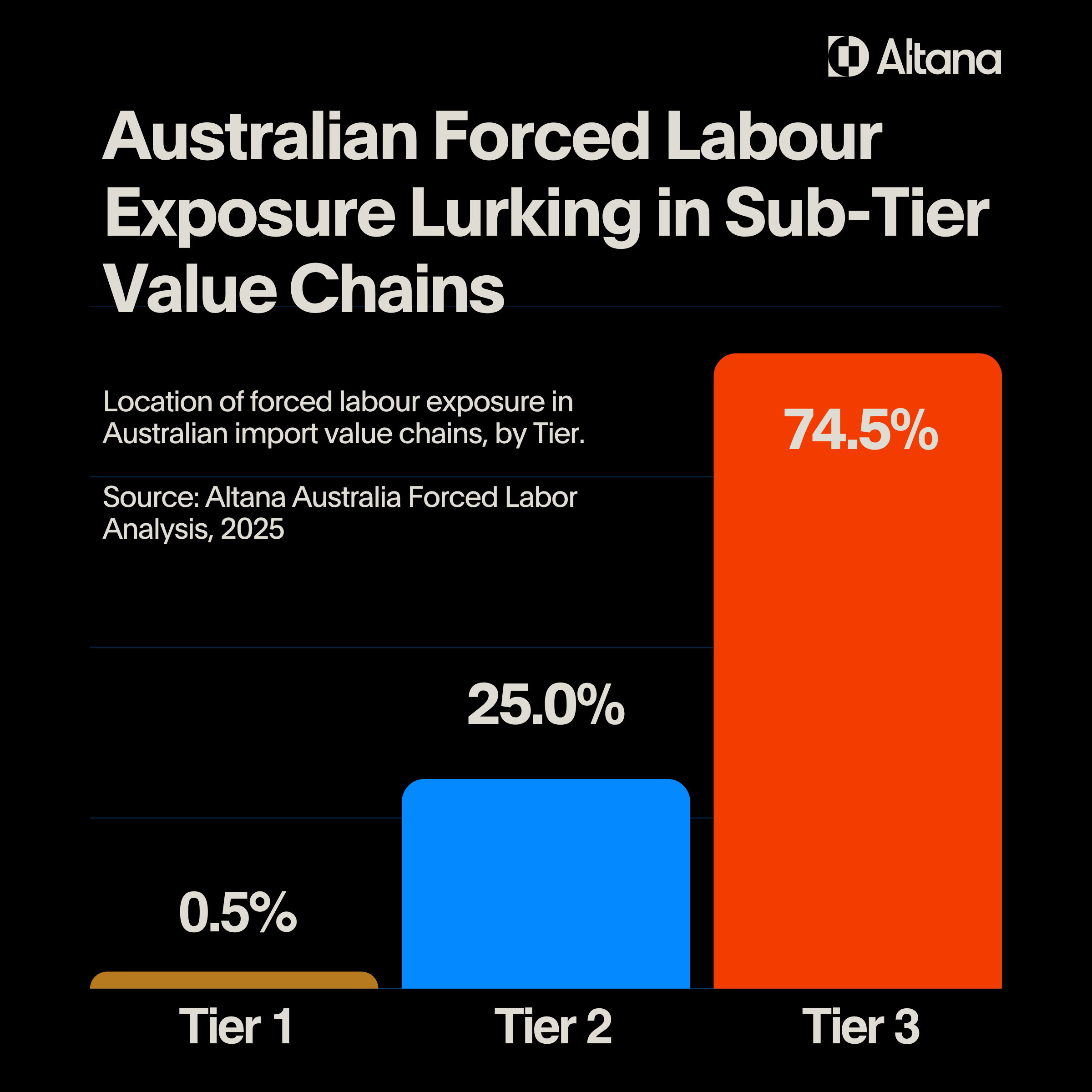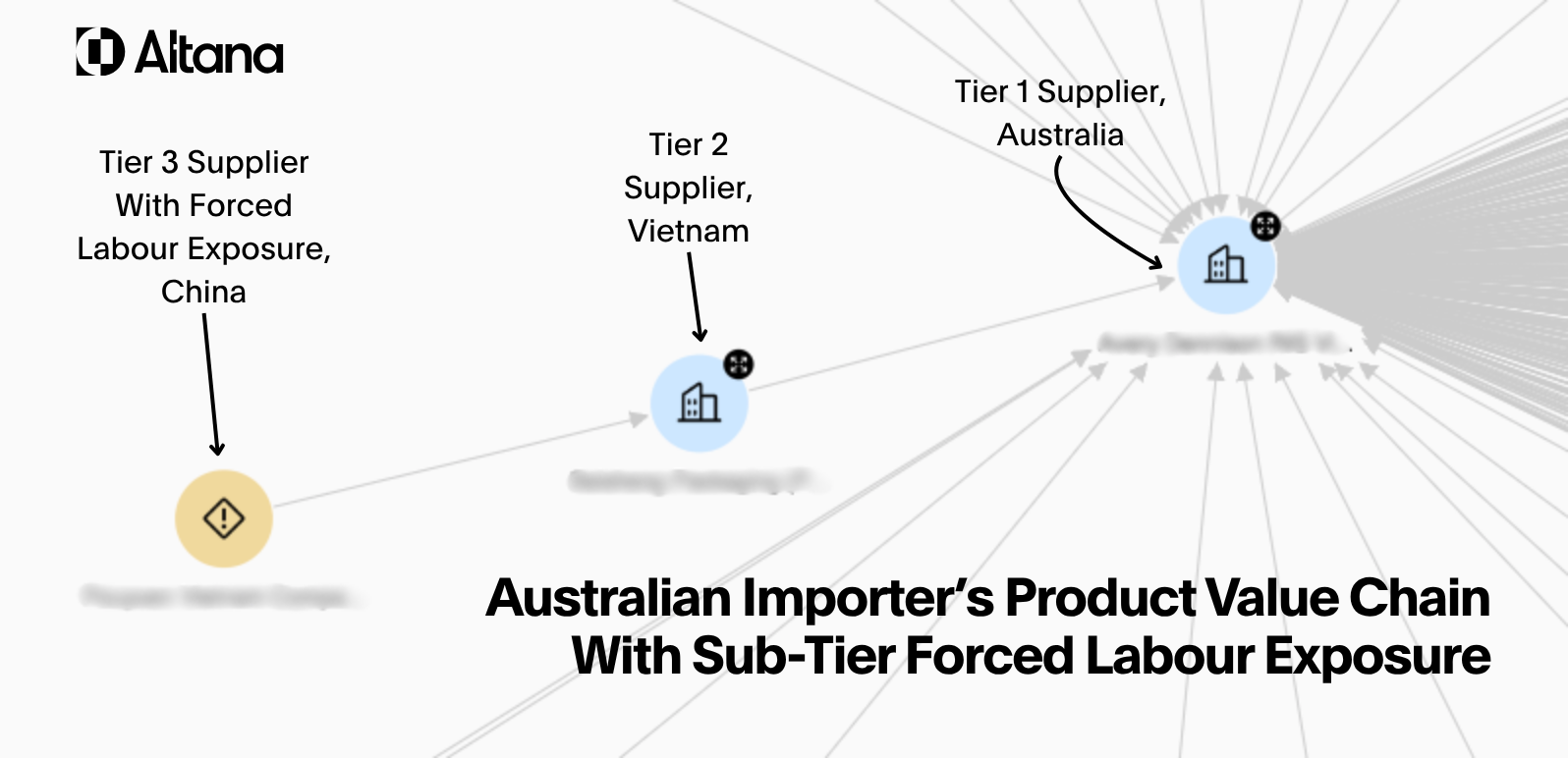Analysis uncovers a large volume of sub-tier forced labour present in Australian product value chains; exposure present across a broad range of industries as domestic pressure mounts for crackdown on modern slavery.
An analysis from Altana’s Product Network – built on the world’s most comprehensive body of supply chain data – reveals significant forced labour exposure in the product value chains of Australian companies.
Since the beginning of 2023, 631 Australian companies have conducted 50,805 imports containing exposure to entities flagged by the U.S.’s Uyghur Forced Labor Prevention Act (UFLPA), the analysis found. The vast majority of the potential exposure is present in Tier 2 and further upstream in product value chains, or the network of materials, components, and human inputs from the soil to the store shelves that make up a good. "Australia needs to be prepared for an evidence-based discussion on the right mechanisms to ensure Australian businesses consistently identify, address and remediate modern slavery risks. I will consider if companies should be required to report on the presence of high risk products or suppliers in their supply chains…"
Chris Evans, Inaugural Australian Anti-Slavery Commissioner, April 2025
See the sub-tier, cross-industry nature of Australian forced labour exposure, and learn how the visibility, traceability, and collaboration afforded by Altana’s Product Network makes it possible for governments and private enterprises to enforce and comply with modern slavery regulations.
99.5% of Potential Australian Forced Labour Exposure is Present at Tier 2 or Further Upstream
Without sub-tier visibility into product-level value chains, the Australian government and private enterprises will have limited awareness of forced labour exposure, the Altana analysis reveals.
A full 99.5% of the transactions with forced labour exposure occur in Tier 2 or further upstream in supply chains. Less than 1% of the Australian imports with exposure to entities flagged by the UFLPA have the exposure present in Tier 1 in the value chain; 74.5% of forced labour exposure in Australian supply chains is at Tier 3 or beyond.
Within Altana’s Product Network, there are numerous examples of how upstream forced labour exposure flows into Australia. Even in a case when a major Australian enterprise sources a product component from Australia, that Australian has a supplier from Vietnam that is supplied by a Tier 3 entity from China. This Chinese Tier 3 supplier has been flagged for modern slavery violations.
Australian Companies’ Exposure to Forced Labour Spans Products, Industries
In Australia, exposure to forced labour spans product types and industries.
A multi-tier analysis of Australia-bound trade flow reveals that since 2023, the industry that makes up a plurality of sub-tier exposure to entities flagged under UFLPA has been apparel and textiles (26.3% of affected trade flow). This elevated trade volume is tied to Xinjiang’s status as a cotton powerhouse.
Other industries are also significantly affected, with electronics (20.5% of affected trade flow), plastics (13.6% of affected trade flow), automotive parts (12.5% of affected trade flow), and iron and steel articles (9.0% of affected trade flow) all exposed to a large amount of sub-tier forced labour exposure.
Expose and Combat Forced Labour Exposure With Altana’s Product Network
Altana empowers businesses to discover and qualify suppliers with unmatched, product-level value chain visibility, traceability, and collaboration, and for governments to enforce trade regulations and protect economic security. With Altana’s Product Network, enterprises in Australia can:
- Identify hidden forced labour risks with visibility, traceability, and fully-illuminated upstream value chains.
- Remediate forced labour risks by collaborating with upstream suppliers to collect documentation – or by identifying alternate suppliers.
For governments, Altana’s Product Network makes it possible to:
- Identify both aggregate, economy-wide and individual, enterprise-specific forced labour exposure through access to a unified, continuously updating network.
- Conduct faster, more efficient forced labour and modern slavery investigations by searching and analyzing multi-tier trade flows in minutes.
- Perform proactive collaboration and coordinated action by sharing forced labour insights across agencies, allies, and industry to prevent trade disruptions, promote compliance, and inform policy.
About the Analysis
Altana analyzed 12.3 million transactions of 631 Australian companies with connections to entities flagged by the UFLPA in their product value chains. The multi-tier analysis covered 2023, 2024, and part of 2025.








